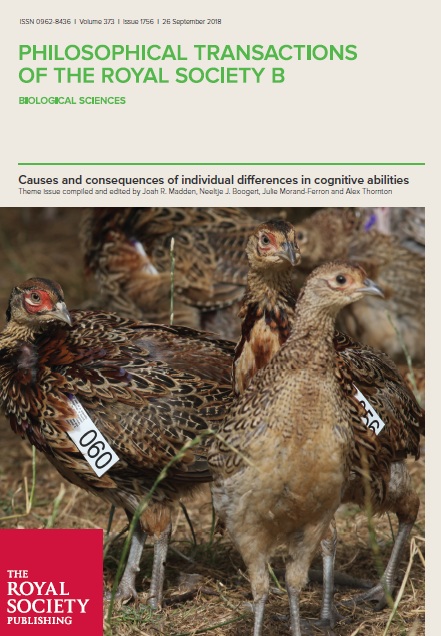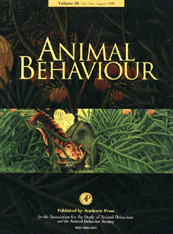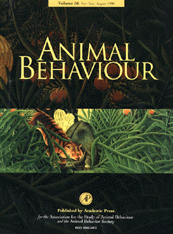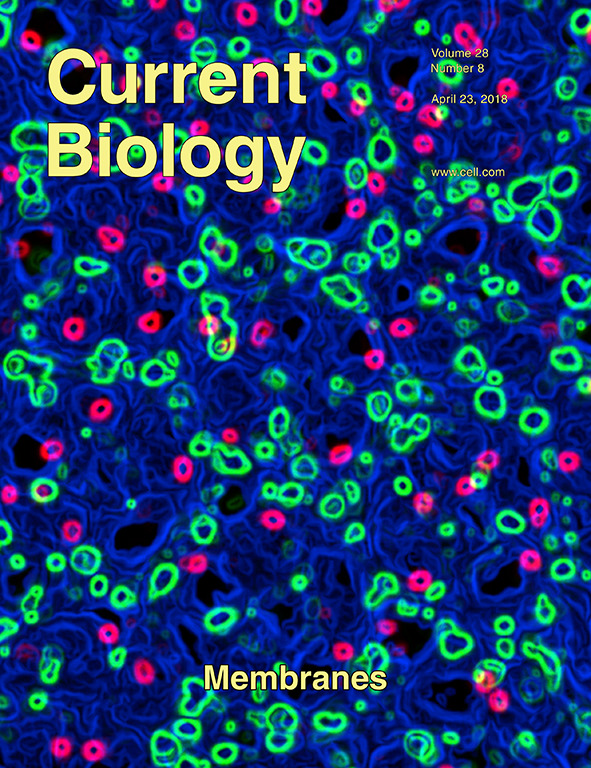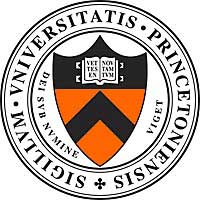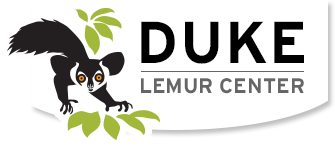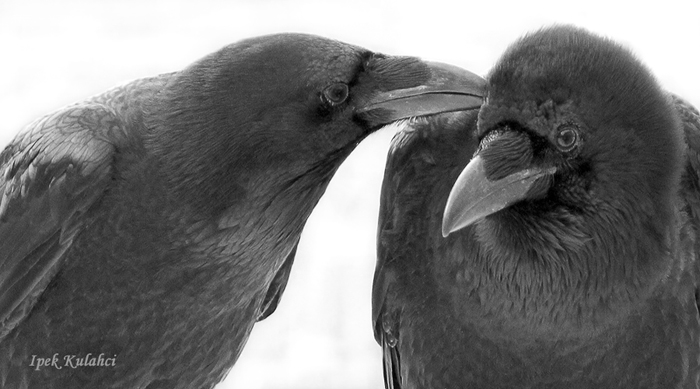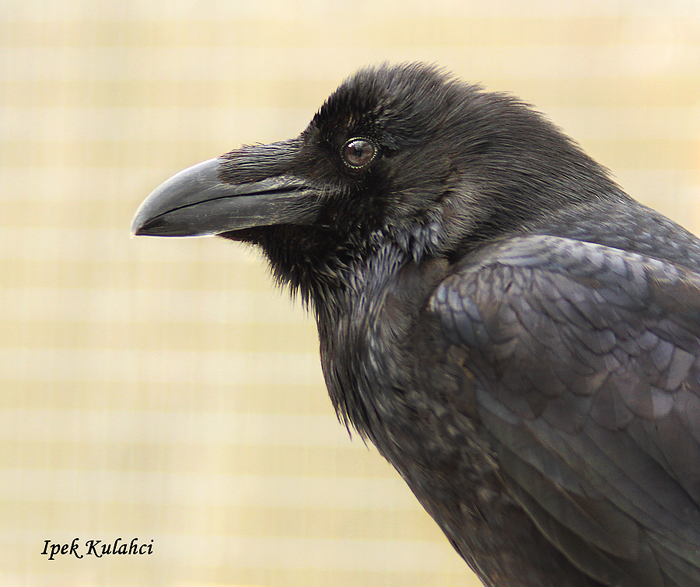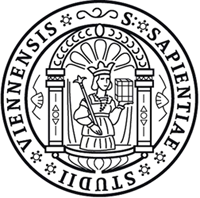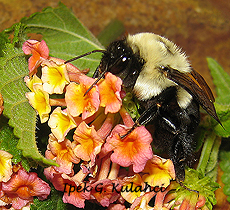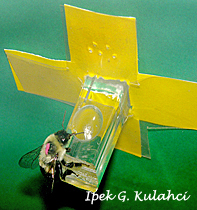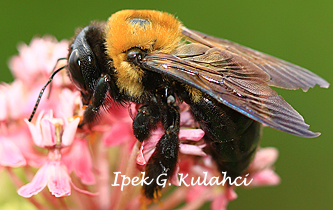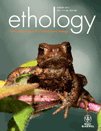
My research projects focus on animal behavior, in particular social behavior, animal cognition, and animal communication, as well as astrobiology.
Individual variation in cognition in wild birds
Social consequences of cognitive variation and information spread
Cognition, communication, and social networks in lemurs
Transmission of information through corvid networks
Learning and decision-making in bumblebees
Caching decisions of Florida scrub-jays
Mate location in Gillette's checkerspot butterflies
Social networks of domestic sheep
Astrobiology
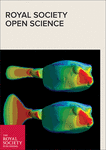

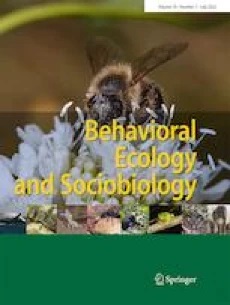
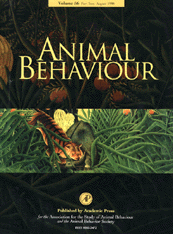

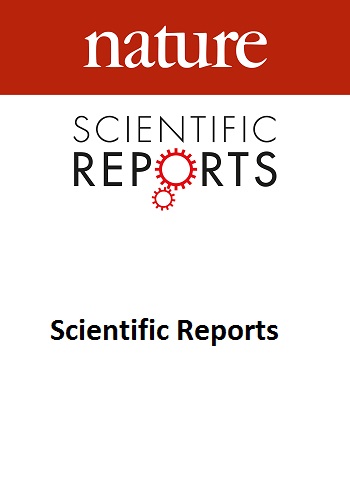
During my postdoctoral research at University College Cork in Ireland, I worked with coal tits (Periparus ater), great tits (Parus major), and blue tits (Cyanistes caeruleus) to study several aspects of cognition including learning, memory, inhibition, problem-solving, individual recognition, and decision-making.
We used PIT tags (Passive Integrated Transponders), in combination with Radio Frequency Identification (RFID) automated feeders, to understand individual variation in learning and memory in wild birds. Our results were published in Royal Society Open Science and Journal of Animal Ecology.
We also explored the links between song recognition, territoriality, and breeding success, as outlined in our paper in Behavioral Ecology and Sociobiology. Furthermore, we studied inhibitory control, both within the context of breeding in the wild, and within the context of foraging and personality in captivity with wild-caught birds who were briefly brought into captivity for testing before being released back into the wild. We published these studies in Animal Behaviour and Journal of Animal Ecology. Additional research in captivity focused on the role that diet plays in the links between gut microbiota and problem-solving performance, as reported in our paper which is one of the Top 100 in Ecology in Scientific Reports.
Furthermore, we utilized automated data collection systems such as RFID nestbox visit loggers, wildlife trail cameras, thermal cameras, and iButton temperature loggers, to study individual variation in nest material choices and nest-building decisions, as well as the consequences of these decisions for nest structure, nest function, and reproductive success.

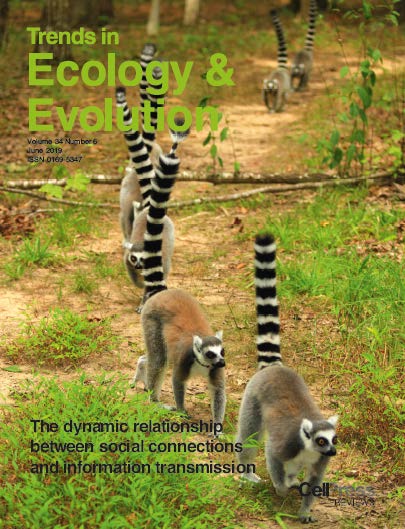
Cognitive abilities such as attention, learning, and memory, all play important roles in social interactions. While individuals vary in their cognitive abilities, whether and how individual variation in cognition influences social relationships has not received much empirical and theoretical attention. Together with Claudia Wascher, Ellis Langley, and Rachael Shaw, we wrote a review to outline our current knowledge and some future directions. Our paper, "How does cognition shape social relationships?", was published in Philosophical Transactions of the Royal Society B in 2018.
Individuals vary in when and how they learn about their environment. Such variation leads to unequal distribution of information among conspecifics in a group, providing opportunities for group members to observe and learn from each other. In many species, the patterns of information spread between individuals is influenced by the social connections between them. However, it is also possible that learning about the environment and displaying novel behaviors based on this information influences the social value of individuals, leading to a dynamic relationship between information transmission and social connections. Our opinion paper addressing these dynamics is published in Trends in Ecology and Evolution and is also featured on the cover of the June 2019 issue.
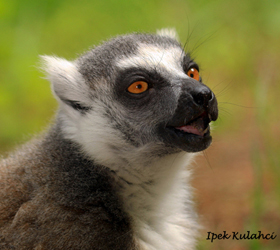
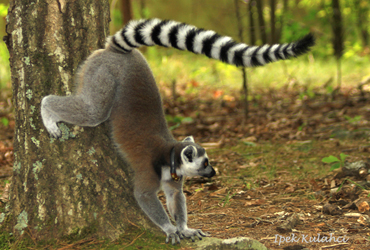
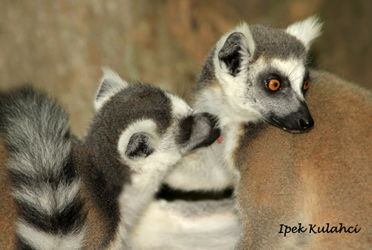
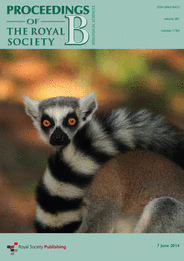
My Ph.D. dissertation focused on understanding the links between social relationships, communication, and cognition. Many group-living species display high social selectivity in their social behavior by interacting with some, but not all, of their conspecifics. I worked with ring-tailed lemurs (Lemur catta) to address the mechanisms behind this social selectivity and its consequences for cognition. My dissertation was supported through grants and fellowships from Princeton University, American Society of Primatologists, American Society of Mammalogists, and Animal Behavior Society.
The ability to recognize individuals is critical for maintaining selectivity in social interactions. In collaboration with my Ph.D. advisors Dr. Asif Ghazanfar and Dr. Daniel Rubenstein, and Dr. Christine Drea from Duke University, we tested whether lemurs use information from multiple sensory modalities to recognize group members. We demonstrated that lemurs recognize familiar females by matching their vocalizations and scents. Our paper titled "Individual recognition through olfactory - auditory matching in lemurs" was published in Proceedings of the Royal Society B: Biological Sciences in 2014, and was featured in Duke University, Natural History magazine (June 2014), Science et Vie Découvertes, and in the cover of Proceedings of the Royal Society B.
Lemurs are very vocal. They frequently produce contact calls that elicit vocal responses from others. However, we found that these vocal responses are highly selective, and that lemurs preferentially respond to the contact calls of the conspecifics with whom they share strong social bonds. Our Animal Behaviour paper titled "Lemurs groom-at-a-distance through vocal networks" was featured in Princeton University, ScienceNews, Nature World News, Pacific Standard, Daily Mail, and Today's Science, and Science Editor's Choice.
Lemurs vary in their social behavior; some are highly social while others are not as social. By quantifying these differences using social network analysis, we found that such individual variation in social behavior is highly consistent, and that it carries over across years and across different behaviors such as grooming, aggression, and communication. These consistencies are likely to be due to social preferences and personalities that persist during different life stages. Our paper "Consistent individual variation across interaction networks indicates social personalities in lemurs", was published in Animal Behaviour special issue on social networks, and was featured in Duke University, Duke Chronicle, and Biosphere.
By comparing lemurs' social relationships and social network position before and after a task-learning experiment, we demonstrated that lemurs preferentially form social relationships with knowledgeable group members who successfully learn and use novel information. The lemurs who solved the task quickly and who were frequently observed while solving the task received more affiliative behaviors and became more socially central than they were before the experiment started. Our Current Biology paper titled "Knowledgeable lemurs become more central in social networks" was featured in a dispatch by Andy Whiten, and by Princeton University, Current Biology, Princeton Alumni Weekly, IFL Science, SciShow, Geek.com, La VanGuardia, The Wildlife Society, and BBC Wildlife.
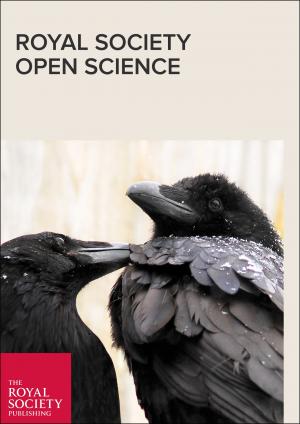 As part of my Ph.D. research, I worked with ravens (Corvus corax) to investigate how social relationships influence learning and information transmission. In collaboration with Drs. Christine Schwab and Thomas Bugnyar from the University of Vienna in Austria, and Dr. Will Hoppitt from UK, we constructed networks from affiliative interactions (e.g. preening), aggressive interactions, and close physical proximity. We then tracked the spread of novel information about how to open a box to access a food reward. Ravens selectively observed and learned from the group members with whom they shared strong social bonds. Our paper "Social networks predict selective observation and information spread in ravens" was published in Royal Society Open Science, and was featured in University of Vienna news (German, English), derStandard, Neue Zürcher Zeitung, Wiener Zeitung, LeScienze, Washington Post, and also in the cover of Royal Society Open Science.
As part of my Ph.D. research, I worked with ravens (Corvus corax) to investigate how social relationships influence learning and information transmission. In collaboration with Drs. Christine Schwab and Thomas Bugnyar from the University of Vienna in Austria, and Dr. Will Hoppitt from UK, we constructed networks from affiliative interactions (e.g. preening), aggressive interactions, and close physical proximity. We then tracked the spread of novel information about how to open a box to access a food reward. Ravens selectively observed and learned from the group members with whom they shared strong social bonds. Our paper "Social networks predict selective observation and information spread in ravens" was published in Royal Society Open Science, and was featured in University of Vienna news (German, English), derStandard, Neue Zürcher Zeitung, Wiener Zeitung, LeScienze, Washington Post, and also in the cover of Royal Society Open Science.
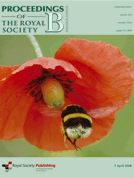 For my master's thesis, I investigated whether signals in multiple sensory modalities provide an advantage for learning and decision-making. Humans, for example, show a trade-off between the speed and the accuracy of decisions. This trade-off has also been shown in other species including bees. Together with my advisor, Dr. Daniel R. Papaj at the Department of Ecology & Evolutionary Biology, University of Arizona, we presented bees with an artificial flower patch in which only some flowers provided nectar. When the flowers differed in shape and scent, the bees were able to better distinguish between rewarding and non-rewarding flowers, in comparison to when the flowers differed only in their shape. A speed-accuracy trade-off was present during all decisions. However, bees' decisions were consistenly more accurate across a range of speeds when flowers differed in both shape and scent. We published our results in Proceedings of the Royal Society B: Biological Sciences in 2008.
For my master's thesis, I investigated whether signals in multiple sensory modalities provide an advantage for learning and decision-making. Humans, for example, show a trade-off between the speed and the accuracy of decisions. This trade-off has also been shown in other species including bees. Together with my advisor, Dr. Daniel R. Papaj at the Department of Ecology & Evolutionary Biology, University of Arizona, we presented bees with an artificial flower patch in which only some flowers provided nectar. When the flowers differed in shape and scent, the bees were able to better distinguish between rewarding and non-rewarding flowers, in comparison to when the flowers differed only in their shape. A speed-accuracy trade-off was present during all decisions. However, bees' decisions were consistenly more accurate across a range of speeds when flowers differed in both shape and scent. We published our results in Proceedings of the Royal Society B: Biological Sciences in 2008.

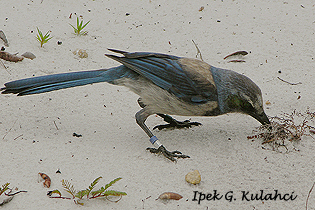
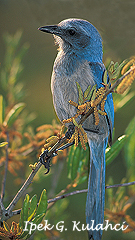
I was a research intern for Dr. Reed Bowman at the Archbold Biological Station in Florida, where I studied food storing (caching) behavior of Florida scrub-jays. Multiple species pilfer each others' caches, and one strategy to avoid pilferage is to cease caching when others are present. Caching, therefore, provides a window into multiple aspects of animal cognition including learning, memory, and decision-making. Jays frequently recover the food items that they had previously cached. I investigated whether the decision to eat or recache a recovered item is influenced by the social environment or by the abiotic factors that influence cache viability. Jays avoided potential social conflicts by flying away from the cache recovery site. However, their post cache-recovery decisions were significantly influenced by the habitat properties that determined cache viability. We published our results in Ethology in 2011.
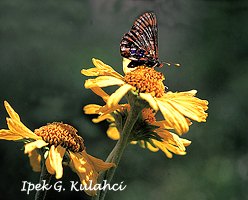
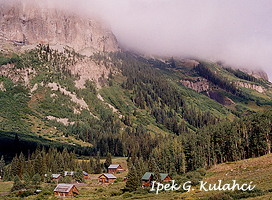
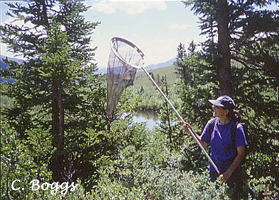
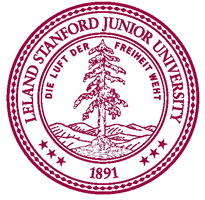
I obtained my undergraduate degree from Stanford University (Biological Sciences Department) where I was advised by Dr. Carol Boggs. We conducted our research at the Rocky Mountain Biological Lab in Gothic, Colorado. I worked with Euphydryas gillettii (Gillette's checkerspot), a butterfly species native to Wyoming but experimentally introduced to Colorado in 1975. During my first summer, we witnessed a population explosion that we outlined in our paper in the Journal of Animal Ecology in 2006. I then followed up on this by investigating the mate-location strategies of E. gillettii males. Males either perch and wait for the females or they fly over the habitat and seek females. We found that habitat factors, weather conditions, and the presence of other males all influenced the mate-location strategy that dominated in the population. This honors' thesis research was supported by Center for Conservation Biology and by an HHMI grant from Undergraduate Research Opportunities.


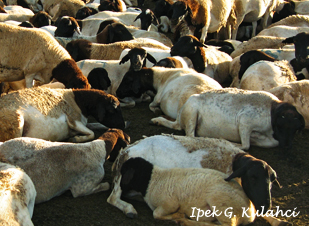

During my first year as a graduate student at Princeton, my cohort and I went to Kenya, where one of my advisors, Daniel Rubenstein, has been conducting behavioral research on equids for many years. Our "Tropical Ecology" course was lead by Daniel Rubenstein (Princeton), Iain Couzin (Princeton) and Tanya Berger-Wolf (University of Illinois at Chicago). We tracked the social interactions and group movement in domestic sheep by fitting the sheep in our study site with GPS units. By combining the GPS data and daily observations, we constructed social networks based on social interactions and movement to demonstrate individiual differences in social behavior and movement decisions.


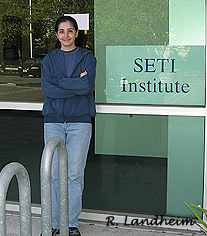
Between 2007-2009, I had the great opportunity to work at the SETI Institute and NASA Ames Research Center in Mountain View, CA. During this period, I took a short break from animal behavior to pursue my other academic interest: astrobiology. Astrobiology is the study of "origin, evolution, distribution, and future of life in the universe" (astrobiology.nasa.gov). As biologists, we study life and its diversity. However, all life as we know it represents a sample size of only one. Finding other life forms on other planets would be one of the biggest discoveries we will ever make. Astrobiology integrates astronomy, cosmology, planetary sciences, physics, chemistry, and biology, and thus has something to attract the interest of everyone.

